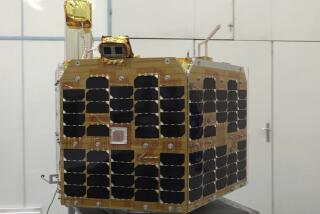Soviets Launch Their Version of Secret Satellite
WASHINGTON — An intelligence-gathering satellite that may be larger than a U.S. satellite to be launched next week was put into space by the Soviet Union in September, the magazine Aviation Week and Space Technology said today.
The Soviet satellite, which intercepts radio communications, is in an orbit that frequently takes it over the United States.
The U.S. satellite to be carried aloft by the space shuttle Discovery on Jan. 23 is destined to be in a geosynchronous orbit 22,300 miles over the Equator. It is meant to monitor Soviet transmissions.
The Soviets have criticized that mission as “preparations for ‘Star Wars.”’ Before last week’s arms talks meeting, the newspaper Pravda wrote:
“Soon after the Geneva meeting a spaceship with a tip secret military mission will be launched in the United States. It will ‘suspend a particularly important reconnaissance satellite over the U.S.S.R.
“it is not concealed in Washington that the purpose of the launching of the satellite, which costs $300 million, is to show that the Ronald Reagan Administration continues preparations for ‘Star Wars’ which it does not intend to give up.”
The Soviet satellite, Aviation Week said, is 530 miles high and orbits Earth 14 times a day.
The American satellite weighs about 5,000 pounds. The Soviet one was lifted with a Proton booster capable of placing up to 50,000 pound payloads into low Earth orbit.
The magazine said the Sept. 28 launch “was conducted in such an unusual manner that the U.S. Air force Space Defense Operations Center in Colorado Springs, Colo., had to marshal its forces to maintain surveillance of the vehicle as it maneuvered extensively in space.”
Other military satellites the Soviet Union has in orbit are 10 photo reconnaissance, 9 early warning, 4 ocean radar and 3 ferret (electronic intelligence). The United States has 3 early warning, 4 photo reconnaissance, 3 ferret and 2 ocean surveillance.
More to Read
Sign up for Essential California
The most important California stories and recommendations in your inbox every morning.
You may occasionally receive promotional content from the Los Angeles Times.










